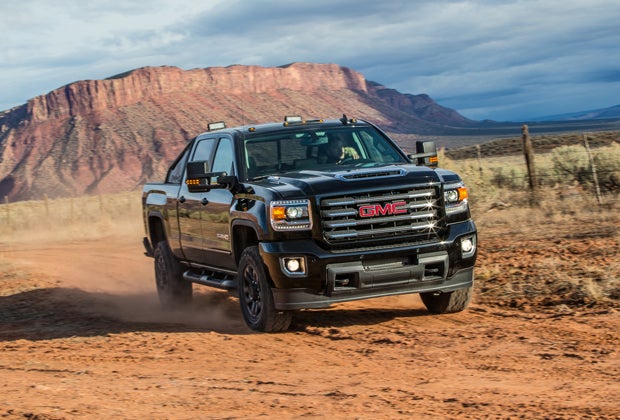
GMC’s Sierra HD may not be entirely new for 2017, but its most popular engine, the 6.6L Duramax diesel, is about as “all new” as it gets in spite of being built on the same block design. Nearly everything in the engine has a new part number, and in turn the turbo-diesel engine increases torque output by 19 percent and horsepower by 12 percent over the previous 6.6L Duramax, giving it a segment-leading 445 horsepower rating and a competitive 910 lb.-ft. of torque rating.
GMC actually unveiled its new Duramax last year just prior to the Texas State Fair in September. At the time, we took a few short drives in the truck at Texas Motor Speedway, pulling a trailer near the oval track and then charging around a cone course on the infield. It was a nice quick impression but not very in-depth. To give us far more time behind the wheel of its 2017 Sierra HDs, GMC recently invited us to drive its new trucks from Moab, Utah, to Telluride, Colorado, and we learned a lot about the new engine and the HD lineup overall.
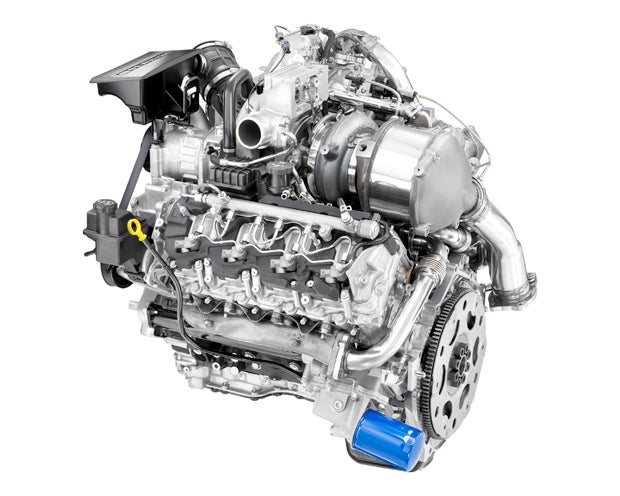
New Fifth-Generation Duramax L5P
GMC was frank about its new engine updates being, in many ways, in an effort to meet more stringent emission standards. This presented an opportunity for the brand to make significant changes to the engine in the emissions department while also bringing more performance to the table for customers.
The new 6.6L relies on the same block as its predecessor and even features the same bore and stroke (103 x 99 mm), but the new engine will be working even harder than the last, and in turn GMC has beefed up its toughness and durability as a result. The fifth-generation Duramax features almost 90 percent new parts, with a new stronger block and cylinder head leading the way. The new aluminum cylinder head features a double-layer water core construction (similar to a honeycomb layout) designed to create a stiffer structure overall while allowing for improved coolant flow control. The new turbo-diesel also employs five nodular iron main bearings and features induction-hardened cylinder walls. The 90-degree V8 features a deep-skirt design and cross-bolted main caps for additional block strength, and GMC notes the lower crankcase is constructed of aluminum to further strengthen the block. The new Duramax is designed to have quieter operation as well thanks to a new two-piece oil pan that features a laminated lower base section to reduce noise transmitted from the engine.
The new parts don’t stop there, as the new Duramax features new pistons, larger-diameter piston pins, larger-diameter crankshaft connecting rods, and an all-new forged and precision ground micro-alloy steel crankshaft. To help keep temperatures down and improve durability, GMC employs larger piston-cooling jets at the bottom of the cylinder bores to spray twice and much oil under the pistons. Airflow to the engine is also improved thanks to a functional air scoop built into the patent-pending hood of the truck (which also features a water separator to keep H20 out).
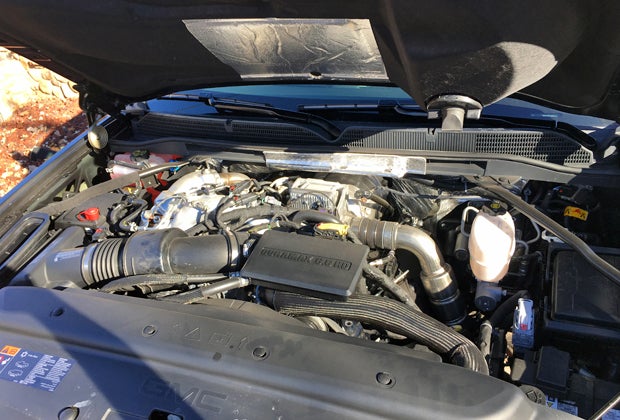
With the improvement in airflow to the engine compartment, GMC also employs an enhanced oiling circuit to improve flow capacity to the new variable-vane turbocharger. The new turbo runs a higher boost than the previous generation and also can withstand hotter temperatures, so GMC says it is designed to deliver prolonged peak power and is capable of performing in temperatures of 1435 degrees Fahrenheit. The new turbo system is more efficient thanks to both its design and improved seals, so not only can it run hotter but it also can capture more exhaust energy to improve the exhaust braking that’s so crucial to diesel trucks pulling a load.
The exhaust system itself is improved thanks to new seals that allow it to run hotter, which is part of why the new engine offers improved breaking torque compared to the previous generation. GMC says it uses new iconel gaskets at six key points in the exhaust that are more efficient than stainless steel gaskets.
To aid in reducing emissions and improve performance, the new 6.6L Duramax uses an electronic throttle valve to help regulate intake manifold pressure in an effort to increase the exhaust gas recirculation (EGR) rates. The EGR system is cooled on the new Duramax as well, as it actually recirculates some of the spent exhaust and mixes it back into the fresh air intake stream to feed into the cylinder head for combustion.
Not much was changed with the returning six-speed Alisson A1000 transmission, though the output yoke was strengthened to handle the increase in power, and changes were also made to the torque converter (including a new seal).
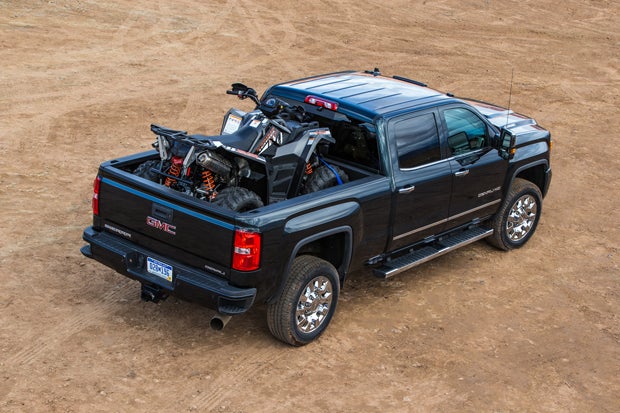
Hauling the Load
Our driving impression route for the 2017 Sierra HD trucks was about as good as it gets. We started our drive at Sorrel Ranch in Moab, Utah, with our final destination being the ski town of Telluride, Colorado. Not only was the route perfect for getting an honest impression of the new truck on uphill and downhill grades, but it also provided a stunning view along the way.
Back when we first drove the new Duramax L5P in Texas, we were missing some of the most crucial information: what are the trailering capacities for the new diesel? The new Duramax has best-in-class horsepower at 445 and isn’t far off from the other “Big Three” in terms of torque output at 910 lb.-ft.. The maximum towing capacity for its 2500 is 16,400 pounds and 23,300 pounds for the 3500. Although the 23,300-pound maximum rating is a far cry from the 30,000-pound rating offered by both of its main rivals, GMC says it isn’t concerned with winning the claim war. The goal of its new Duramax is to focus on “the heart of the market” and improving the experience for that customer. Since GMC says the vast majority of its customers tow trailers in the range of 12,000 to 15,000 pounds, this claim doesn’t feel like a sales pitch or marketing angle – GMC wants to provide a good experience for the masses and not appeal to the small handful of people towing over 22,000 pounds.
To see just how this new Duramax actually feels on the open highway, we left Moab in the morning with a fleet of Sierra HDs loaded with a variety of different vehicles, including ATVs, snowmobiles and a 5,000-pound trailer pulling a fleet of Polaris ATVs. We hopped behind the wheel of a grey Sierra 2500 HD Denali loaded with a Polaris Scrambler 1000 in the bed. The first thing we noticed after firing up our truck which was how quiet it was, and it was clear that GMC’s claim that the new Duramax is 38 percent quieter wasn’t just lip service. As we motored out of town, there was only the occasional reminder when stepping on the throttle that you’re driving a turbo-diesel engine, as the overall operation is refined and relatively quiet for what one might expect.
The Polaris ATV in our truck bed tips weighs roughly 750 pounds, giving us an honest feel for the truck with a little more than half its available 1335-pound payload. Our Sierra Denali handled the weight like it was hardly even there, cruising down the windy country roads confidently, with the updated twin-tube Rancho shocks from the off-road suspension package soaking up the bumps along the way. The truck feels great on the road, and it proves that the once stiff and rough feel of previous 3/4-tons work trucks are now comfortable enough for family road trips.
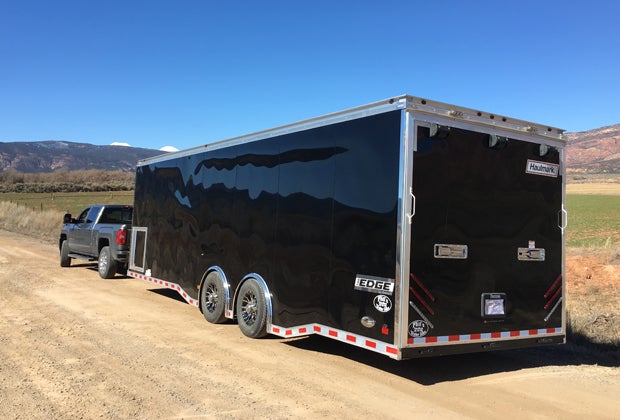
Our lunchstop in Paradox, Colorado, offered even more chance to test the capability of the new Duramax. Since we were one of the first to get there, we took advantage of driving the Sierra HD All Terrain on a short off-road course. The All Terrain is available on SLT models, and it swaps out 20s for 18-inch aluminum wheels fitted with more aggressive Goodyear DuraTrac tires. It also features side steps, a bed-mounted sport bar and unique badging and styling. Our off-road course wasn’t exactly challenging, but it did help us prove the 2500 HD doesn’t feel out of its elements in the dirt.
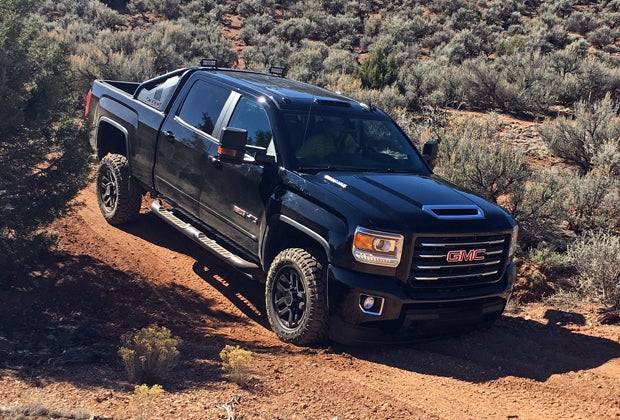
After shifting into 4WD we traversed a few cross-rutted sections and climbed up and down some weathered slopes. Our biggest concern with wheeling the HD much is the placement of the DEF tank, which sits just below the passenger-side front door. The tank sits rather low and appears vulnerable, but some of our concern was laid to rest when we learned the tank features a beefy steel skid plate. This truck likely won’t be a serious off-roader for most, but we’re happy to see that GMC does help protect the tank in the event it clips a rock or rut. The front air damn is also something to be mindful of off-road, as it limits the front end ground clearance of the truck considerably. Even our mild trail needed to be taken with caution with the pieces attached (something we’d suggest removing if you plan to be off of the highway regularly). When all’s said and done, even with the heavier diesel engine the 2500HD All Terrain isn’t afraid of getting dirty from time to time, even if it is a bit limited with how much it can handle.
After our drive in the All Terrain, we headed straight for the 2500 HD pulling an enclosed trailer. We had a few loop options around the surrounding mountain roads, and the trailer, loaded with a GMC Canyon, put the weight right at about 10,000 pounds. Pulling away from a dead stop, with tow-haul mode and the exhaust brake engaged, the powerful low-end torque of the new Duramax got us up to speed quickly. Our route put us back into some of the windy turns we had just driven down when coming into town with only an ATV loaded in our bed. These types of windy roads are where truck drivers pulling a trailer need the most confidence, as uphill and downhill sections require complete concentration to keep the truck within the lines. It could be argued that this is also where diesels are most valuable, as the torquey engines don’t require the driver to think too hard about proper power delivery – when needed, just give the truck more throttle and the on-demand power is there.
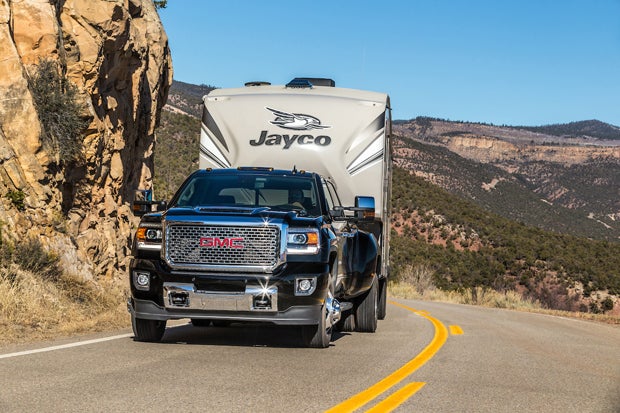
One of the features GMC has thoughtfully included in its tow/haul mode is the ability to hold a speed for the driver. The speed is set after the driver taps on the brake, and it is helpful for both uphill and downhill sections, and the driver can also simply fine-tune the speed using the cruise control settings. The exhaust brake on the Sierra works great, helping to slow the truck down for when the driver gets off the throttle or begins braking. It makes a 10,000-pound trailer feel far less intimidating during a tight downhill turn. The digital steering assist feature introduced on the Sierra in 2016 also contributes to the great handling of the truck. The system aids in reducing the amount of effort needed to turn the truck, making ease of operation far less taxing for extended drives. We also hopped behind the wheel of a dually 3500 fitted with a fifth-wheel travel trailer, also weighing near 10,000 pounds. The truck felt even easier to operate than the 2500 pulling the enclosed trailer, as the lack of tongue weight thanks to the in-bed gooseneck connection made the drive that much smoother.
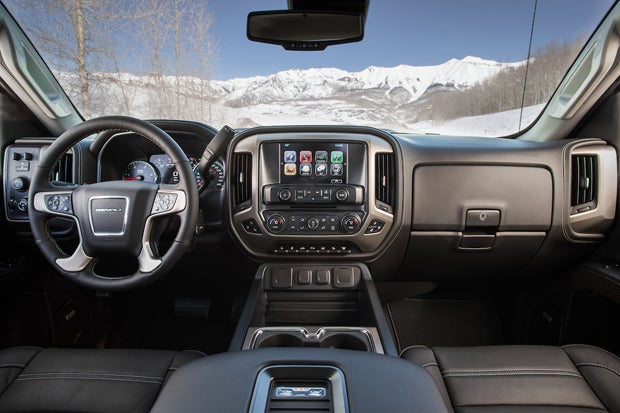
Although the changes for the 2017 Sierra HD are focused on the engine, the Denali trim packages we drove throughout the event definitely highlight GMC’s top-level offering. GMC says that nearly 50 percent of its vehicles sold are Denalis, and that for its HD trucks 75 percent of the sales are premium trims, meaning either SLT or Denali. To GMC, this customer expects comfort, refinement and great ride quality. Outside of the truck, the bold GMC styling is immediately apparent thanks to its squared grille, 20-inch wheels and body-color bumpers. Inside the truck is where the bold styling turns plush, with leather heated seats, infotainment that features everything from satellite radio to Apple CarPlay and Android Auto integration, wireless phone charging and an upgraded Bose audio system. About the only thing we could find missing on GMC’s upper level trim is electronic controls for steering wheel adjustment. The Denali looks to offer a premium experience for its customers, and we certainly felt like we drove in style throughout our trip.
It should be noted that the 2017 Sierra HD will be offered with an optional Vortec 6.0L V8 (360 hp, 380 kb-ft or torque), though GMC says that most of its premium model buyers will opt for the Duramax, with 90 percent of its Denali customers opting for the diesel engine. Pricing for the Sierra HD starts at $35,085, but if opting for the diesel engine and the SLT or Denali package that price can nearly double. The test truck we spent the majority of the day in was a Denali 2500 Crew Cab with 4WD priced at $70,540. That’s certainly a steep price tag, but it does come in about $7,000 less than a 2017 F250 4x4 Platinum PowerStroke model we recently tested.
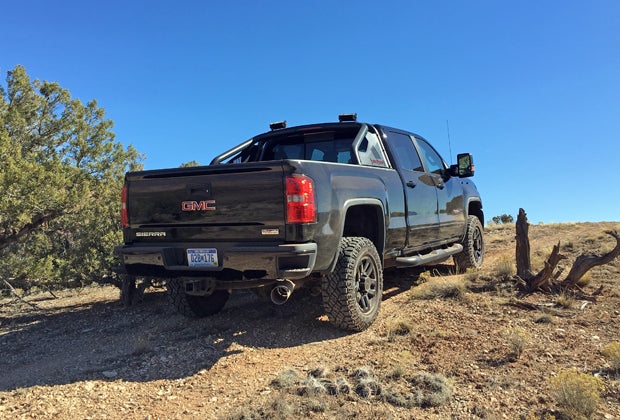
Ready for the Long Haul
GMC’s new Duramax brings a lot to the table for the 2017 GMC Sierra HD, providing added power and confidence for hauling whatever load you have behind it. GMC says most of its HD customers say that whatever they haul behind their truck – whether it be a camper, off-road vehicle, heavy equipment or boat – is the most prized possession they own. The added power of the new Duramax paired with the Denali trim makes the 2017 Sierra HD both comfortable and confident for whatever task you need it to perform.


 Your Privacy Choices
Your Privacy Choices